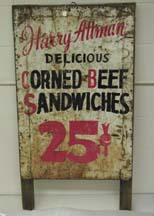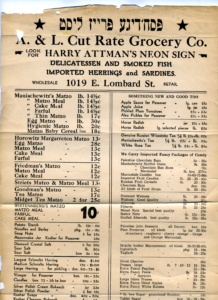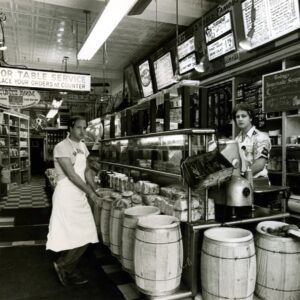Bedlam with Corned Beef on the Side Part X
Written by Barry Kessler. Originally published in Generations 1993, reprinted in Generations 2011 – 2012: Jewish Foodways.
Part X: The Longest Survivor

Painted metal and wood sign advertising Attman’s corned beef sandwiches., c. 1930. JMM 1992.121.1
Attman’s Delicatessen is the longest survivor of the East Baltimore delis, still busy on Lombard Street where it is now one of the few remainders of the community which once thrived there. It remains in the family, although the Attmans have prospered and now hold extensive real estate and other businesses interests. Yet it was one of the most recent delis to convert from a take-out grocery to a sit-down restaurant.
Harry Attman came to Baltimore around 1920. An immigrant from a village near Kiev who had learned the grocery trade in Providence, Rhode Island, he was the oldest child of a large family and the first to immigrate. He brought the others over, including his parents, one at a time. He and his wife Ida, from Poland, purchased a small grocery at 2000 East Baltimore Street. They continued to live there even after 1933, when they acquired the beginnings of today’s deli, a small grocery store at 1019 East Lombard Street, then owned by Nathan and Elise Weinstein.[1] They bought out their partner in the purchase, Lipshitz, by 1940, but continued to call the place A. and L. Cut Rate Grocery Company for several years. Meanwhile, Harry’s brother Joseph and his brother-on-law Morris Sefret purchased the Atlantic Import Company, only one block down Lombard Street, from Philip and Pincus Cohen.[2] Abraham, Anna, Joseph, and Shmare Attman were earning their livings at Atlantic Import in 1937.

Menu for A & L Cut Rate Grocery Co., Harry Attman’s. JMM 1989.47.14
Photographs and price lists from the 1930s[3] show Harry Attman’s carrying on a bustling trade in Jewish food specialties, especially at Passover. Mail orders from customers and retail groceries far and wide formed a large component of the business. Besides packaged matzah and other kosher-for-Passover products, Attman’s offered coffees, teas, nuts, dried fruit, spices, herring, and delicatessen meats. The store cured its own pickles; raw vegetables came from the Marsh Market near the Fallsway at a quarter a barrel, and McCormick & Co. and Baltimore Spice ground loads of garlic to a special course blend for its use.[4]
The nature of the business changed dramatically during the 1940s. As the Jewish community moved away from East Baltimore and supermarkets drew away price-conscious grocery shoppers, Harry Attman and his son Seymour, who increasingly helped with the business, focused more on sliced meats and the luncheon trade of hot dogs and sandwiches. Although AHarry and Ida were religious people and kept a kosher home, the corned beef and tongue sold at Attman’s came from non-kosher sources and the delicatessen never presented itself as kosher. Indeed, although during the war years the local rabbis successfully enforced the observance of Sabbath, afterwards Attman’s and the other shops on Lombard Street defied their authority and opened on Saturdays.

Interior of Attman’s delicatessen, by Elinor B. Cahn, 1984. JMM 1985.31.2
After the war Attman’s proudly promoted the slogan “Home of Fifty Sandwiches.” Leaning up against a counter in the narrow, crowded shop, patrons could eat sandwich combinations Harry and Seymour Attman invented or borrowed from famous uptown delis such as Nates and Leon’s, and Ballow’s, or the Carnegie Del in New York. Five years after his father’s death in 1968 Seymour Attman opened the “Kibitz Room,” decorated with posters and old photographs; customers carried their sandwiches over on plastic trays. Since then the clientele has become increasingly non-Jewish, now ranging up to 65 percent during luncheon hours.
More than two hundred delicatessens are listed in today’s Yellow Pages – some of them direct or indirect descendants of specialty grocery stores established by Jewish immigrants from Eastern Europe in Baltimore decades ago; others related to them only be association, real or intended, with the concept of a lively, aromatic, ethnic sandwich shop. The remarkable personalities of the great delicatessens and the flavors of their foodstuffs constitute a uniquely American Jewish heritage that has enriched Baltimore as a whole.
~The End~
Notes:
[1] Baltimore City Directory, 1937.
[2] Interview with Seymour Attman (December 1992).
[3] Jewish Museum of Maryland, 1990.89.
[4] Interview with Seymour Attman (September 1992).
